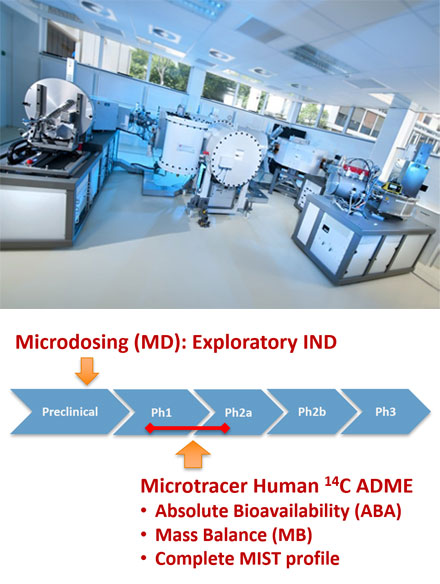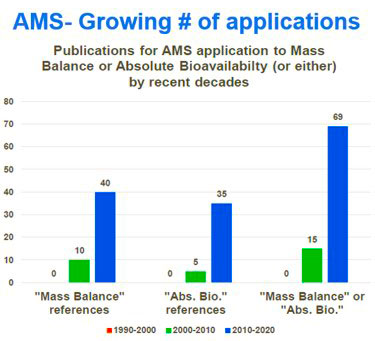ACCELERATE YOUR CLINCAL DEVELOPMENT
MICROTRACING WITH AMS TECHNOLOGY LEADS TO FASTER DRUG DEVELOPMENT
Clinical Microtracer Research with Accelerator Mass Spectrometer (AMS)
The development of new medicines is a costly and time consuming process. One way to increase the efficiency of drug development pipelines is by using microtracer dosing. Microtracing is an innovative technology in which very small quantities of substances are tested in humans at a very early stage of development. No more than 100 micrograms, or 30 nmoles for proteins, are administered. This is less than one hundredth of the expected therapeutic dose, a quantity that does not cause side-effects.
A movie is created to explain the AMS technology, please click right to view
AMS allows scientists to analyze microtracers at low (fg/ml) levels.

Introducing highly sensitive analytical technologies such as AMS and Microtracer at earlier stages of drug development (e.g., Phase 1 or 2 clinical trials) allows for the acquisition of critical human pharmacokinetic (PK) data.
This data includes Mass Malance (MB), Absolute Bioavailability (ABA), Human-specific metabolite assessment (MIST), and Metabolite Identification (MetID).
This approach represents a Paradigm shift that offers multiple significant benefits:
● It removes ethical barriers associated with drug development, notably by reducing radiation exposure for clinical trial participants.
● It reduces costs by potentially minimizing or eliminating some animal testing.
● Most importantly, it significantly shortens development time.
This accelerated process not only enables a more timely and accurate assessment of drug candidates' success rates but also extends patent exclusivity after marketing approval
(potentially increasing the effective term by 10 months to nearly 3 years).
Revolutionized sample preparation
TNO has the unique ability to fully automate blood, plasma, urine or fecal sample analysis by AMS, based on auto-combustion.
This differs significantly from the standard graphitization-based approach.
Auto-combustion sample preparation allows us to analyse more samples per day, ensures a faster turnover time, and is more economical because it is far less labour-intensive.
It also eliminates the need for material recovery and reduces recovery time for human volunteers.
- Validated total carbon-14 count in 2μl plasma (LLOQ 0.65 mBq/mL) -
Application and Service
| Exploratory IND Phase-0 | By applying microdosing, TNO can determine the fate of new medicines very early in drug development (Phase 0). We can measure the pharmacokinetics of a substance, and all together, this information makes it possible to determine whether or not the medicine is compatible with a patient-friendly dosing regimen. Since extensive pre-clinical research is scarcely needed to do a microdosing study, fewer lab animals need to be sacrificed before the compound can be used in humans. The main advantage of microdosing is that it supplies extra information, based on research in humans, to arrive at an optimal go-no go decision. Taken the results of the microdosing studies into account, the Phase 1 trials can be designed much more effectively. A typical microdosing study consists of approximately 4-6 volunteers per compound. |
|---|---|
| Mass Balance + MIST during Phase-I, or II | During Phase-I or II, any microtracer study is a potential MIST study, which will present the entire human metabolite profile. TNO’s facility is unique with both High Resolution MS and AMS. Directly after chromatographic separation the flow is split, whereby one part is on-line coupled to a High Resolution MS for direct metabolite identification. Simultaneously fractions are collected for off-line total radio-activity quantitation by cAMS. |
| Absolute Bioavailability during Phase-I, or II | Medicines are commonly administered to humans for the first time in Phase 1 trials, to obtain primary data on pharmacokinetics. We can help extract more information from that compulsory research stage by adding a microtracer intravenously on top of your ‘common’ Phase 1 study and including the AMS in the subsequent analysis. This way, we can measure how much of the substance is absorbed and thereby determine the absolute bioavailability. |
| BIOLOGICALS / BIOSIMILAR | Biologicals (and biosimilars) are an upcoming class of drug compounds, unfortunately with a relatively high failure rate during drug development. This is mainly caused by the lack of suitable preclinical models to study PK profiles. Microdosing offers the superior advantage to obtain human data for biologicals, prior to a Phase 1 study and after limited preclinical safety testing. The biological can be radio-labeled using carbon-14 or iodine-129. The first microdosing study with a biological therapeutic protein in humans demonstrated excellent dose- proportionality. In addition a microdose can be used as a safe starting dose of biotherapeutics for FIM studies. Obviously, not for all biotherapeutics dose-linearity between microdose and therapeutic dose is expected. In these cases microdosing in combination with in vitro and PBPK modelling can still be of high value to predict pharmacokinetics at the therapeutic dose. |
| Analytical service Investigational drug production |
- 14C labeling of API. Other isotopes: 26Al, 129I and 41Ca (can be done by either GMP or Non-GMP) - Analytical method development and validation. - Sample analysis (AMS、LC-hrMS, LSC, LLSC, Microbeta2), Traditional LC-MS/MS |
Related FDA Guidance
Link: FDA: Clinical Pharmacology Considerations for Human Radiolabeled Mass Balance Studies. July 2024
Link: FDA: Safety Testing of Drug Metabolite. March 2020
Link: FDA: Pharmacokinetics in Patients with Impaired Renal Function. March 2024

Flux Analysis using 14C and AMS; De Novo Lipogenesis, Muscle Protein Turnover, etc
Metabolic flux measurements play an important role in advancing our understanding of (patho)physiology, disease mechanisms and the development of new therapeutics.
By incorporating stable or radioactive isotopes into specific molecules (tracers), the distribution and fate of the isotope can be followed ? thereby providing insight into the movement and metabolic transformation of biomolecules.
An isotope that is frequently used for such analyses is 13C, which is analyzed by isotope ratio mass spectrometry. The high natural abundance of 13C (~1%) requires the use of large amounts of labelled substrates, especially in clinical studies.
An alternative isotope is 14C, which has an extremely low natural abundance (ca. one in a trillion). In combination with analysis by extremely sensitive accelerator mass spectrometry (AMS), this enables the detection of very small amounts of 14C-labeled product/biomarker at very low (microtrace) amounts of labelled substrate administration.
Application
● De Novo Lipogenesis (DNL)
● HDL funcitionality / Reverse Cholesterol Transport
● Muscle Protein Synthesis & Breakdown (combined 14C and D2O analysis)
● Glucose Metabolism (DNL, conversion to fluctose)
Technical info:
●
Flux Analysis using 14C and AMS
Technologies with AMS and Microtracing (OPEN FOR PARTNERING)
| Pediatric Microdosing | ・Paediatric Accelerator Mass sPectrometry Evaluation Research (PAMPER). 2010: Grant from Priority Medicines for Children Program. ・Pediatric microdosing: elucidating age-related changes in oral absorption to guide dosing of new formulations. 2011: Grant from Priority Medicines for Children Program in The Netherlands (ZonMW) |
|---|---|
| Screening of Proteins, ADC, Peptides | ・How to discriminate different Antibodies/ADC/Peptides in target tissue or plasma? |
| Evaluation of ADC, Payload, | ・ADC: Tracing of Payload (Linker, Warhead) in human body |
| Evaluation of Biosimilar, Biosimilarity | ・Clinical trial (Phase 0) to determine PK. ・Expose Human volunteers to Approved Biologic and Biosimilar Simultaneously |
| Efficacy | ・De Novo Lipogenesis |
| Application for Cosmetic, Chemicals | ・Reference:
Assessment of Dermal Absorption of Aluminum From a Representative Antiperspirant Formulation Using a 26 Al Microtracer |
Human Microtracer studies symposium, April 21st, 2022

The symposium was held in the Fletcher Hotel Leiden, The Netherlands on April 21st.
Both the clinic of ICON as well as the AMS laboratory of TNO have conducted a large number of microtracer studies during the last 10 years.
The increased interest in microtracer studies triggered ICON and TNO to have organised this one-day symposium to share experiences, to discuss hurdles and challenges.
Microtracer studies have found broad application in early clinical drug development over the past ten years.
Especially human ADME and Absolute Bioavailability (ABA) single-arm microtracer studies have found traction among both large and smaller sized pharmaceutical companies.
□ Publication download Considerations for Human ADME Strategy and Design Paradigm Shift(s)- an Industry White Paper.
Publication
Antimicrobial Agents and Chemotherapy, Sep 2025
Mass balance, pharmacokinetics, metabolism, and excretion of radiolabeled acoziborole, a potential novel treatment for human African trypanosomiasis, following single microtracer oral dose to humans
Drug Metabolism and Disposition, Aug 2023
Mass Balance and Absorption, Distribution, Metabolism, and Excretion Properties of Balcinrenone following Oral Administration in Combination with Intravenous Microtracer in Healthy Subjects.
Drug Metabolism and Disposition, July 2023
THE METABOLISM OF LUFOTRELVIR, A PRODRUG INVESTIGATED FOR THE TREATMENT OF SARS-COV-2, IN HUMANS FOLLOWING INTRAVENOUS ADMINISTRATION
Drug Metabolism and Disposition, Apr 2023
Application of Accelerator Mass Spectrometry to Characterize the Mass Balance Recovery and Disposition of AZD4831, a Novel Myeloperoxidase Inhibitor, following Administration of an Oral Radiolabeled Microtracer Dose in Humans.
Clinical Pharmacology in Drug Development 2022, 11(7)
A Phase 1 Study to Assess Mass Balance and Absolute Bioavailability of Zimlovisertib in Healthy Male Participants Using a 14 C-Microtracer Approach.
Drug Metabolism and Disposition, Aug 2022
The Pharmacokinetics, Metabolism, and Clearance Mechanisms of Abrocitinib, a Selective Janus Kinase Inhibitor, in Humans.
Poster at ISSX/MDO 2022
Accelerator Mass Spectrometry (AMS) Enabled Human ADME study of the FGFR Inhibitor Derazantinib.
Drug Metabolism and Disposition, Feb 2022
Characterization of Clinical Absorption, Distribution, Metabolism, and Excretion and Pharmacokinetics of Velsecorat Using an Intravenous Microtracer Combined with an Inhaled Dose in Healthy Subjects
Clinical Pharmacology & Therapeutics, May 2020
The Oral Bioavailability and Metabolism of Midazolam in Stable Critically Ill Children: A Pharmacokinetic Microtracing Study
Clinical Pharmacology & Therapeutics, May 2020
Proof of Concept: First Pediatric [ 14 C]microtracer Study to Create Metabolite Profiles of Midazolam
British Journal of Clinical Pharmacology, Oct 2019
Dose-linearity of the Pharmacokinetics of an Intravenous [ 14 C]midazolam Microdose in Children
ESDPPP, May-2019
Pediatric Microdose study of oral [14C] midazolam; simultaneous metabolic profiling and quantitation using hrMS and AMS
Clin Transl Sci. 2018 Nov;11(6):573-581. doi: 10.1111/cts.12579. Epub 2018 Jul 27.
Assessment of Dermal Absorption of Aluminum From a Representative Antiperspirant Formulation Using a 26 Al Microtracer
Drug Disovery Today, April 2016
The Impact of early human data on clinical development, there is time to win.
Press release with Pfizer、Feb, 2019
MICROTRACING WITH AMS TECHNOLOGY LEADS TO FASTER DRUG DEVELOPMENT, Feb, 2019
Clinical Pharmacology, 2015
Microdosing of a Carbon-14 Labeled Protein in Healthy Volunteers Accurately Predicts Its Pharmacokinetics at Therapeutic Dosages.
Clinical Pharmacokinetics. Sep 2014;
Pediatric Microdose Study of [14C]Paracetamol to Study Drug Metabolism Using AMS.
Clinical and Translational Science, Feb, 2016.
Microdosing and Other Phase-0 Clinical Trials; Facilitating Translation in Drug Development.
Clinical Pharmacokinetics, Aug, 2015.
To Apply Microdosing or Not? Recommendations to Single Out Compounds with Non-Linear Pharmacokinetic
British Journal of Clinical Pharmacology, Jan, 2015
Observational infant exploratory [14C]-paracetamol pharmacokinetic microdose/therapeutic dose study with accelerator mass spectrometry bioanalysis.
British Journal of Clinical Pharmacology, July, 2012.
Simultaneous oral therapeutic and intravenous 14C-microdose to determine the Absolute Oral Bioavailability of Saxagliptin and Dapagliflosin.

